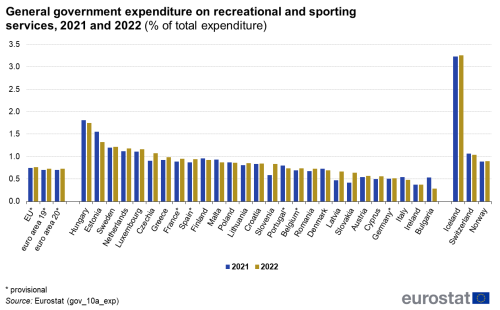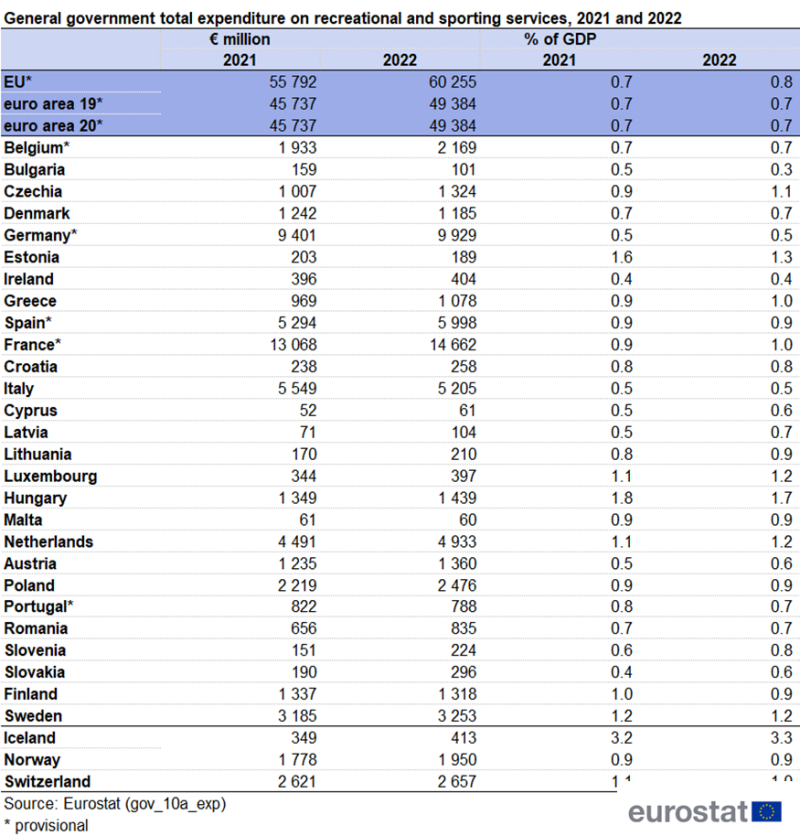Government expenditure on recreational and sporting services
Data extracted on 29 February 2024
Planned article update: February 2025
Highlights
In 2022, general government expenditure across the EU on recreational and sporting services amounted to €60.3 billion or 0.8 % of all general government expenditure.

(%)
Source: Eurostat (gov_10a_exp)
This article presents statistics related to general government expenditure on recreational and sporting services in the European Union (EU). It is based on data gathered by Eurostat as part of the data collection on government expenditure by economic function, according to the classification of functions of government (COFOG).
Data presented in this article relate to recreational and sporting services, i.e. group 08.1 of the COFOG classification (please see its description below, in the part 'Data sources').
Full article
General government expenditure on recreational and sporting services
In 2022, the general government expenditure across the EU on recreation, culture and religion (COFOG division 08) accounted for 2.3 % of total government expenditure, while expenditure on recreational and sporting services - a subset of expenditure on recreation, culture and religion - made up 0.8 % of total government expenditure. This percentage has remained quite stable since the beginning of the time series, fluctuating only between 0.7 % and 0.8 % of total expenditure.
In two EU Member States, the share of government expenditure on recreational and sporting services matched the EU percentage in 2022, thirteen Member States recorded figures above it and the other twelve Member States below it.
In 2022, the highest shares of general government expenditure on recreational and sporting services were recorded in Hungary (1.7 %), Estonia (1.3 %), Sweden, the Netherlands and Luxembourg (all 1.2 %), and, among EFTA countries, in Iceland (3.3 %). The lowest shares in total expenditure were observed in Bulgaria (0.3 %) and Ireland (0.4 %).

(%)
Source: Eurostat (gov_10a_exp)
The general government expenditure on recreational and sporting services as a share of GDP stood at 0.4 % in 2022, unchanged from 2021. The ratio remained stable in the majority of the Member States.
In absolute terms, EU general government expenditure on recreational and sporting services was €60.3 billion in 2022, increasing from €55.8 billion in 2021 (see Table 1).

Source: Eurostat (gov_10a_exp)
Source data for tables and graphs
Data sources
Government finance statistics are collected by Eurostat on the basis of the European System of Accounts (ESA 2010) transmission programme. EU Member States are requested to transmit, among other tables, table 1100 on the ‘Expenditure of general government by function’ 12 months after the end of the reference period. Table 1100 provides information about expenditure of the general government sector divided into main COFOG functions and ESA 2010 categories.
Provisional data
While a significant effort was undertaken to harmonise the recording of government measures to alleviate the impact of increasing energy prices, a full harmonisation of data for the reference year 2022 was not yet achieved.
Data for the EU and euro area aggregates (2022), Belgium (2022), Germany (2020-2022), Spain (2022), France (2021-2022) and Portugal (2022) is provisional.
Classification of government expenditure by function
General government expenditure by classification of the functions of government (COFOG) is collected at two levels of detail. At its most aggregate level it classifies government expenditure into 10 main functions (divisions or COFOG level I breakdowns): general public services; defence; public order and safety; economic affairs; environmental protection; housing and community affairs; health; recreation, culture and religion; education; social protection. These divisions are further broken down into groups (COFOG level II).
COFOG division 08 'recreation, culture and religion' consists of the following COFOG groups:
- 08.1: recreational and sporting services;
- 08.2: cultural services;
- 08.3: broadcasting and publishing services;
- 08.4: religious and other community services;
- 08.5: R&D related to recreation, culture and religion;
- 08.6: recreation, culture and religion not elsewhere classified.
Recreational and sporting services covered by COFOG Group 08.1 include:
- administration of sporting and recreational affairs;
- supervision and regulation of sporting facilities;
- operation or support of facilities for active sporting pursuits or events (playing fields, tennis courts, squash courts, running tracks, golf courses, boxing rings, skating rinks, gymnasia, etc.);
- operation or support of facilities for passive sporting pursuits or events (chiefly specially equipped venues for playing cards, board games, etc.);
- operation or support of facilities for recreational pursuits (parks, beaches, camping grounds and associated lodging places furnished on a non-commercial basis, swimming pools, public baths for washing, etc.);
- grants, loans or subsidies to support teams or individual competitors or players.
Further information is available in Eurostat’s manual on sources and methods for the compilation of COFOG statistics — 2019 edition.
Definition of general government total expenditure
Government total expenditure is defined in ESA 2010, paragraph 8.100 by using as reference a list of ESA 2010 categories.
Government total expenditure comprises the following categories:
- P.2, 'intermediate consumption': the purchase of goods and services by government;
- P.5, 'gross capital formation' consists of: (a) gross fixed capital formation (P.51g); (b) changes in inventories (P.52); (c) acquisitions less disposals of valuables (P.53); where
- P.51g, 'gross fixed capital formation': consists of acquisitions, less disposals, of fixed assets during a given period plus certain additions to the value of non-produced assets realised by the productive activity of producer or institutional units. Fixed assets are tangible or intangible assets produced as outputs from processes of production that are themselves used repeatedly, or continuously, in processes of production for more than one year;
- D.1, 'compensation of employees': the wages of government employees plus non-wage costs such as social contributions;
- D.29, 'other taxes on production, payable',
- D.3, 'subsidies, payable',
- D.4, 'property income, payable', consists of : (a) 'interest, payable' (D.41) and (b) 'other property income, payable' (D.42+D.43+D.44+D.45), where
- D.41, 'interest': excludes settlements under swaps and forward rate arrangements, as these are treated as financial transactions in the ESA 2010;
- D.5, 'current taxes on income, wealth, etc, payable';
- D.62, social payments: cover social benefits and pensions paid in cash;
- D.632, 'social transfers in kind - purchased market production';
- D.7, 'other current transfers, payable';
- D.8, 'adjustments for the change in pension entitlements';
- D.9, 'capital transfers payable';
- NP, 'acquisitions less disposals of non-financial non-produced assets': public investment spending. Non-financial non-produced assets consist of land and other tangible non-produced assets that may be used in the production of goods and services, and intangible non-produced assets.
- Capital investments includes P.5 and NP.
- Other current expenditure includes D.29, D.5 and D.8.
Gross Domestic Product
Throughout this publication, nominal GDP, i.e. GDP at current prices is used.
Context
Sport is part of the wider EU policy agenda, which includes achieving the EU's social and economic goals. Since 2011, the Commission and EU countries have worked together on the basis of multiannual work programmes agreed by the Council (EU Work Plan for Sport for 2014–2017; EU Work Plan for Sport 2017–2020; EU Work Plan for Sport 2021–2024) which set priorities and define the principles underpinning cooperation.
A number of expert groups have been set up to achieve concrete results. Among them, the Expert Group 'Sport and economics' (XG ECO) and the Expert Group on Health-Enhancing Physical Activity (XG HEPA) play a key role in implementing evidence-based policies in the sports sector. XG ECO, for example, has produced the economic definition of sport ('Vilnius definition'), and made progress towards developing Sport Satellite Accounts in some EU countries. XG HEPA concentrates on implementing the Council recommendations on physical activity adopted in 2013. These include a monitoring framework with indicators both on the level of physical activity and on policies to promote physical activity in the EU Member States.
Eurostat comparable data on sport employment, international trade, participation in sporting activities etc. is an important tool to contribute to the monitoring and development of the EU’s sport policies.
Direct access to
- Government statistics (gov)
- Government finance statistics (EDP and ESA 2010) (gov_gfs10)
- Annual government finance statistics (gov_10a)
- Government revenue, expenditure and main aggregates (gov_10a_main)
- General government expenditure by function (COFOG) (gov_10a_exp)
- Annual government finance statistics (gov_10a)
- Government finance statistics (EDP and ESA 2010) (gov_gfs10)
- EU Work plan for Sport for 2021–2024
- EU Work plan for Sport for 2017–2020
- Resolution of 21 May 2014 of the Council and the Representatives of the Member State Governments, meeting within the Council, on the EU Work Plan for Sport (2014–2017) (2014/C 183/03)
- Summaries of EU Legislation: Sport's role in promoting growth, jobs, social inclusion and health
- Leaflet on sport statistics — 2018 edition
- Government expenditure by function - online publication